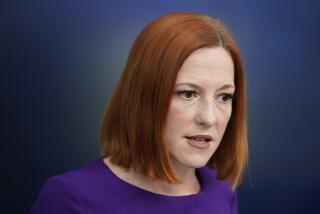Secretaries Are Gaining Status as Demand for Them Increases
- Share via
NEW YORK — The first thing they would like to do is expunge the term just, as in “just a secretary.”
Next, champions of this field would like to train every executive in the universe not to refer to his secretary as “my girl.”
Finally, they would like to reaffirm the oft-repeated truism that if every chief executive officer in the United States took a day off, business would continue as usual. But if every secretary stayed home, business would screech to a standstill.
Certainly technology is all but on the verge of rendering the steno pad a Pleistocene relic. The field is changing, evolving with every new office microchip. Still, said Eleanor Vreeland, head of one of the country’s oldest continuous secretarial schools, “if we had enough time to talk about all the name changes we have discussed, at the end of the day, secretary is still the word that best describes the job, just as executive best describes that particular position.”
As president and chief executive officer of the Katharine Gibbs School Inc., Vreeland scheduled a luncheon not long ago to discuss changes in one of the fastest-growing professions in the country. One thing that Vreeland, a former secretary at the now-defunct ladies’ clothing firm of Peck & Peck, wanted to point out was how her field was emerging from its battle with the women’s movement, how “we are still coming out of the age when people thought of secretarial work as demeaning.”
One entire generation may have said why be a nurse when you can be a brain surgeon, why be a legal secretary when you can be a lawyer, but “high school graduates now,” Vreeland said, “are just not into that whole thing we were into as recently as five years ago, when people were saying secretarial work was demeaning. High school students today hear that and they don’t know what we’re talking about.”
Vreeland may have been eager to bolster her contention that secretaries are no longer suffering from a bad rep, that “I think what has happened is that the secretary’s role has been accepted as very important,” but she also was interested in tendering some impressive statistics. Figures from the U.S. Department of Labor, she reported, show “80,000 secretarial spots going unfilled yearly.” The same Department of Labor predicts that in the next five years the field will burgeon, she said, by “500,000 new secretarial jobs over and above what there are today.”
In Los Angeles County in 1984, secretaries occupied 178,368 positions. Projections for 1985 showed the figure growing to 185,775.
Industry is growing “more and more into service and research organizations,” she said, resulting in a rapidly expanding demand for workers with clerical skills. “There just aren’t enough secretaries,” Vreeland said. “It’s as simple as that.”
Those who do step into these vacant secretarial slots will find that an increasingly technological office place--”it takes a genius just to operate the new telephones,” Vreeland joked--is also a more financially satisfying work environment.
Higher Starting Salaries
“In the last three years,” she said, “there has been a 20% increase for beginning-level secretaries.” In New York last year this meant entry-level secretarial salaries ranging from $15,000 to $17,000, and “we think they’re going to go even higher.”
As secretary to a chief executive officer, moreover, Vreeland said, “you can expect to command salaries of $35,000 to $40,000--and more.”
(Average secretarial wages in Los Angeles County for 1984 were $6.73 per hour.)
Money may pay the VISA bills, but it isn’t the only payoff, Vreeland said: “The secretary to the chairman of the board, that is a very powerful position.”
Indeed, she went on, in spite of competition from a bumper crop of ambitious young MBAs, it is not merely a wild pipe dream for a secretary to contemplate climbing the corporate ladder. Former secretary Mary Jarratt, for example, is now Ronald Reagan’s assistant secretary of agriculture for food and consumer services, and another one-time secretary who rose to rather meteoric heights was a man named Lyndon Johnson, later the 36th President of the United States.
‘Still 98% Female’
Lyndon Johnson notwithstanding, the fact, Vreeland said, is that “the field is still 98% female,” perhaps because for many years, as late, certainly as the 1950s, “women had fewer job opportunities and career paths available to them.”
A secretary was defined originally as the “keeper of the secrets,” Vreeland said, and ironically, “the field started out however many hundreds of years ago as a job for men.”
But maybe the white gloves that Katharine Gibbs’ graduates were once required to wear helped drive men away from the field. A strict dress code prevails, Vreeland said: “If they come to school not dressed the way they should be dressed for work in an office, we send them home.” Improper attire might include something like “net stockings, because they simply are not accepted in the business world today.”
If image is essential to the upgraded image of the secretary, Vreeland said, so is education, “the re-education of both the executive and the secretary.” Regardless of who makes the coffee, or who fetches it, “the relationship between an executive and a secretary who work together for many years is also one that becomes a friend, a partner. We think educating corporate America of the value of a secretary is the way to go.”
More to Read
Get the L.A. Times Politics newsletter
Deeply reported insights into legislation, politics and policy from Sacramento, Washington and beyond. In your inbox twice per week.
You may occasionally receive promotional content from the Los Angeles Times.









